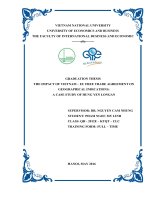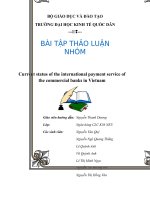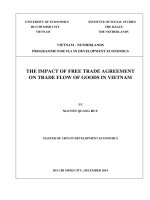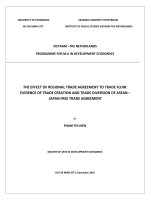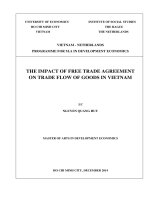(TIỂU LUẬN) the influence of eu vietnam free trade agreement (evfta) on vietnam’s electronics industry what is the right direction for enterprises
Bạn đang xem bản rút gọn của tài liệu. Xem và tải ngay bản đầy đủ của tài liệu tại đây (356.61 KB, 14 trang )
UEH UNIVERSITY
COLLEGE OF BUSINESS
DEPARTMENT OF INTERNATIONAL BUSINESS AND MARKETING
ASSIGNMENT
SUBJECT: INTERNATIONAL BUSINESS
The influence of EU-Vietnam Free Trade Agreement (EVFTA) on Vietnam’s
electronics industry. What is the right direction for enterprises?
NGUYỄN THÚY NGA – KM002 – 31201022059
Abstract: Vietnam’s electronics industry (EI) is one of the fastest-growing and most crucial
industries in Vietnam. The EU and Vietnam signed a Free Trade Agreement in June 2019 have
opened up many opportunities for enterprises to export goods, especially the electronics industry.
This study focuses on analyzing the positives and challenges of UVFTA in Vietnam's electronics
industry using a theoretical framework in international trade policy and data sources produced by
GSO, GDS, and others. Based on the findings, this study gives some recommendations for
Vietnam to make good use of the benefits to promote exports to the EU in the new post-covid-19
period.
Keywords: Vietnam’s electronics industry, UVFTA, opportunities, challenges.
1. The meaning of the research
With the explosion of free trade, trade protectionism is also growing gradually. Countries use
non-tariff barriers to restrict imported goods to protect domestic industry and the economy. One
of the most commonly – used is the technical barrier, which is said to be very useful. Also, Viet
Nam is not an exception when exporting textiles and garments to Japan. Therefore, the study
will show the influence of technical barriers on Vietnam's textile and garments export turnover
and give some recommendations that help Vietnam's textile and garments production adapt to
strict standards of the Japanese market so that its export turnover can increase sustainably.
2. Theoretical framework, trade policy, barriers after EVFTA integration, and the
importance of the electronics industry.
Trade policy is known as a collection of rules and regulations which pertain to trade. Things like
import and export taxes, tariffs, inspection regulations, and quotas can all be part of a nation's
trade policy. The EU-Vietnam Free Trade Agreement (EVFTA) is a free trade agreement between
Vietnam and the 27 EU member states. EVFTA, along with the Trans-Pacific Partnership (TP)
Agreement, are two FTAs with the widest range of commitments and the highest level of
commitment of Vietnam. The main target of EVFTA is to increase opportunities trade for
bussinesses by eliminating barriers to trade, such as Tariffs, Quotas, Voluntary Export Restraints
(VERs) and by ensuring fair competition. For example, after the official entry into force of the
free trade agreement, approximately 65 percent of EU exports to Vietnam and around 70 percent
of EU imports from Vietnam will be exempted from customs duty immediately . Vietnam’s
electronics industry has climbed the rank from a modest 47 th place in 2001 to 12th place in 2019.
Especially, mobile phone exports were ranked second worldwide, with a value of over US$50
billion in 2019. Therefore, it is very necessary to focus on research to promote the total export
turnover of this strategic industry.
3. The fluctuation and integration barriers of Vietnam’s electronics industry – Industry
analysis
3.1 Overview of the electronics industry in Vietnam
The electronics industry is a manufacturing industry with a strategic position in the economy and
has a strong spillover effect on other industries. Vietnam's computer and electronic industry
accounts for 17.8% of the entire industry, mainly manufacturing products such as phones, tablets,
motherboards, monitors, televisions, cameras, etc. office equipment and optical products…
In the 2016-2020 period, Vietnam's electronics industry focused on developing basic electrical
and electronic components, printed circuit boards, and microelectronic circuits for mobile phones
and electronic devices… In the period of 2020 - 2025, priority will be given to the development
of products in such fields as automatic equipment, computers and phones. After 2025, priority
will be given to software development, digital content, information technology services and
medical electronics. In the 2016-2020 period, the export turnover of computers, electronic
products and components continuously achieved a high growth rate. The growth rates in turn are:
in 2016 by 21.5%; in 2017 increased by 38.6%; in 2018 increased by 12.5%; in 2019 increased
by 22.8%; in 2020 increase 22.8%. The average growth rate of the whole period 2016 - 2020
increased by 23.8%, the production index in this period of the electronics, computer, electronic
products and components industries reached a higher level than other manufacturing industries at
an increase of 13,9%. In particular, 2017 reached the highest growth rate of 35.2%. Since the
second quarter of 2020, the electronics manufacturing sector has been affected by the Covid-19
pandemic due to reduced customer demand in key markets, interrupted supply and export orders
were postponed or canceled, but the manufacturing index of the electronic component
manufacturing industry in 2020 grew at 6.8% compared to 2019.
According to the assessment of the Ministry of Industry and Trade, the group of computers,
electronic products and components of Vietnam has well exploited traditional markets and
developed new markets. Vietnam exports computer products and electronic components to over
100 markets around the world. Exporting computer products and electronic components is
mainly to the markets of China, the US, ASEAN, Japan, Korea and is exporting strongly to the
EU market including the Netherlands, Germany, the Czech Republic, Poland, Finland... Notably,
exports increased sharply to other EU member countries such as Hungary, Poland, the Czech
Republic and Slovakia. In particular, focusing on and creating a breakthrough to expand new and
potential export markets in Africa, Latin America, the Middle East and India...
3.2 The fluctuations in the period of development of EI and the impact of the international
trade policy in the EU market.
Period 2016 – 2019
The export value of this commodity group in December 2016 reached more than 1.86 billion
USD, down 1.1% compared to the previous month. Thereby, bringing the export turnover of this
commodity group in 2016 to USD 18.96 billion, up 21.5% over the previous year, equivalent to
an increase of USD 3.35 billion. China is the largest importer of this group of goods of Vietnam
in the year with 4.1 billion USD, up 47.2%; followed by the EU with 3.73 billion USD, up
16.5%; to the US reached 2.89 billion USD, up 2.05%; to the Netherlands reached 1.75 billion
USD, a sharp increase of 53.5%... compared to the previous year.
In 2017, the total export turnover of the electronics industry in the EU market showed signs of
increasing (up about 23.6% over the previous year). The main reason for the increase in export
turnover to the EU market is the high increase in export value of a number of commodity groups
such as computers, electronic products & components by 784 million USD; phones &
accessories increased by 719 million USD; machinery, equipment, tools & spare parts increased
by 575 million USD; footwear increased by USD 428 million; iron and steel increased by 296
million USD... These 5 commodity groups alone contributed 2.8 billion USD, accounting for
65% of the additional turnover of exports to the EU market this year.
In 2018, the main markets that imported computers, electronic products and components from
Vietnam in 2018 were: China: US$8.36 billion, up 21.9%; EU market: USD 5.47 billion, up
18.6%; United States: 2.86 billion USD, down 16.7%… over the previous year. In 2019, exports
of computers, electronic products and components to China reached US$9.56 billion, up 13.8%
over the previous year; to the US market reached 6.05 billion USD, a strong increase of 110.9%;
to the EU market (28 countries) reached 5.06 billion USD, down 8.7%; to Hong Kong reached
3.03 billion USD, up 34.4%; to Korea reached 2.88 billion USD, equivalent to 14.7%
increase...From 2016 – 2018, the export value of electronics continued to increase, but it was still
not the industry that accounts for a high proportion of the top key export industries of Vietnam.
Industries such as textiles, telephones and components still accounted for a higher proportion.
Vietnam's electronics export turnover to EU from 2016 to 2019
6
5.47
5.06
5
4
4.61
3.73
3
2
1
0
2016
2017
2018
2019
Source:
Period 2020 – 2021
The EVFTA came into effect on August 1, 2020. Key aspects of the EVFTA are the dismantling
of customs barriers and the facilitation of European-Vietnamese trade relations. For example,
after the official entry into force of the free trade agreement, approximately 65 percent of EU
exports to Vietnam and around 70 percent of EU imports from Vietnam will be exempted from
customs duty immediately. The remaining customs obligations are to be abolished in perspective
over a path of 10 years (99 percent duty exemption) and 15 years (99.8 percent duty exemption),
with the exception of crude oil and coal . In 2020, within 4 months after the EVFTA comes into
effect, the export turnover of goods to the EU27 market increased due to positive growth in
exports of many items compared to before the EVFTA took effect. In which, the export turnover
of computers, electronic products and components in the 4 months after the Agreement came into
force increased by 47.4% over the same period in 2019, a stronger increase than the increase of
15.3 % in the first 7 months of 2020. However, the increase was limited because many items had
a decrease in export turnover or even stronger decline. before the Agreement entered into force.
In which, the export turnover of consumer goods such as textiles, footwear, suitcases, bags, hats,
umbrellas still decreased compared to the same period in 2019. The export of this group of goods
decreased mainly due to consumer demand. In the EU market decreased due to the impact of the
Covid-19 epidemic. Textile and garment exports tend to slow down, down only 7.2% in the 4
months after the EVFTA comes into effect compared to a decrease of 15.3% in the first 7 months
of 2020. With the high growth rate and large turnover, electronics, computers and components
have surpassed textile and garment to become the third - largest export group of Vietnam. In 4
months, from August to November 2020, the export turnover of Vietnam's goods to Germany
increased mainly due to the export of machinery, equipment, tools and spare parts; computers,
electronic products and components increased sharply, while the three largest exports were
phones and components; footwear; textile and garment still decreased compared to the same
period last year. Therefore, along with high demand in the period of covid 19, the policies of the
EVFTA have contributed to creating favorable conditions for the export electronics industry to
increase rapidly.
Export value of textiles and electronics, computers and components in the period 2016 –
10/2021
2021
2016
2017
2018
2019
2020
(to Oct)
Total export turnover
176.
215.
243.
(billion USD)
Textiles
Electronics, computers and components
6
23.8
19.0
5
26.1
26.3
7
30.5
29.6
264.
282.6
269.77
3
5
32.8 29.81
31.17
36.3 44.58
49.03
Source: www.gso.gov.vn
Although the epidemic situation is still evolving, the export value of the electronics industry is
still on the rise after the EVFTA came into effect. Because Vietnam’s electronics industry is not
affected by non-tariff barriers such as the "Yellow Card" issue like agricultural and fishery
products, etc., it can be said that the development conditions of the electronics industry are quite
favorable. The proof is that in the 10 months of 2021, the export value of computers, electronic
products & components in the month reached 4.22 billion USD, down 11.7% compared to the
previous month, bringing the export value import of this commodity group in 10 months of 2021
to 40.85 billion USD, up 12.2% over the same period in 2020. In 10 months of 2021, the export
of computers, electronic products and components to the EU market (27 countries) reached 5.27
billion USD, up 5.5%...
Export turnover of economics industry to the EU market (the first 10 months in 2021)
700
600
Million USD
500
400
300
200
100
0
1
2
3
4
5
6
7
8
9
10
Source:
The EU is one of Vietnam's most important trading partners. Therefore, thanks to the EVFTA
Agreement, the two-way trade turnover between Vietnam and the EU has grown in a more
sustainable direction, both in terms of quality and quantity, with both import and export
achieving positive results. Moreover, the EVFTA agreement also gives Vietnam the opportunity
to reform institutions, make transparency, improve the investment-business environment and
transform the structure of goods towards exporting valuable goods, high growth rate, creating a
favorable investment environment for companies of both sides.
3.3 Industry opportunities and challenges for Vietnam’s electronics industry in the short
and long term.
3.3.1 Opportunities
In Asia, Vietnam is one of the few countries having a Trade Agreement with the EU (after Korea,
Japan and Singapore). Therefore, the EU-Vietnam Free Trade Agreement (EVFTA) has opened
up opportunities and special import-export advantages for Vietnamese goods.
Firstly, EVFTA ensures the economic security of Vietnam. Overall, the EVFTA will contribute to
diversifying markets so as not to be too dependent on one market, thereby helping to ensure
Vietnam's economic security. As a new generation FTA agreement, EVFTA is like a "Western
Highway", connecting Vietnam to a large market space with leading potential in the world in
terms of both finance, technology and markets... The benefits come from the numbers that can be
seen that as soon as this Agreement comes into force, Europe removes 85.6% of tariff lines,
helping to increase competitiveness by 70.3%. Vietnam's export turnover to this market, Vietnam
removed 48.5%, equivalent to 64.5% of import turnover into our country, helping to reduce input
costs for manufacturing industries, reducing the price of goods. goods and services, opening a
new flow of trade.
Secondly, EVFTA helps recover the Vietnamese economy. From the end of 2019 until now, the
Covid-19 pandemic has strongly impacted and affected the world’s socio-economic situation,
including Vietnam. Many economic experts also believe that economic growth in 2020 will not
reach the set target. In that context, the implementation of the EVFTA is of great significance,
helping to offset the decline of the economy during the epidemic period. From the business side,
the EVFTA provides an opportunity for businesses to expand and diversify markets, regaining
the post-epidemic growth momentum. Research by the Ministry of Planning and Investment
shows that the EVFTA helps Vietnam's export turnover to the EU increases by about 20% by
2020; 42.7% in 2025 and 44.37% in 2030 compared to no Agreement. At the same time, import
turnover from the EU also increased but at a lower rate than exports, specifically about 15.28%
in 2020; 33.06% in 2025 and 36.7% in 2030. Macroscopically, EVFTA contributes to Vietnam's
GDP increase by an average of 2.18% - 3.25% (in 2019 - 2023). ); 4.57% - 5.30% (2024 - 2028)
and 7.07% - 7.72% (2029 - 2033). Besides, in terms of imports, Vietnamese enterprises will also
benefit from the source of imported goods and materials with good and stable quality at a more
reasonable price from the EU.
Thirdly, EVFTA affects Vietnamese employment, social security. According to the Ministry of
Planning and Investment, the EVFTA is expected to add about 146,000 jobs per year, focusing on
labor-intensive industries with high export rates to the EU market. However, some industries are
affected by job reduction such as forestry, mining, and rice production with a decrease of 0.26 to
0.36% per year. The EVFTA will not only bring benefits in terms of the number of jobs, but also
have the ability to increase workers' wages through efficient market operations, and spillover
effects on wages from FDI enterprises.
Fourthly, EVFTA helps strengthen the position of Vietnamese enterprises in the world market. As
for Vietnam's exports, as soon as the EVFTA comes into effect, the EU will eliminate import
taxes on about 85.6% of tariff lines, equivalent to 70.3% of Vietnam's export turnover to the EU.
After 7 years from the date of entry into force of the Agreement, the EU will eliminate import tax
on 99.2% of tariff lines, equivalent to 99.7% of Vietnam's export turnover. For the remaining
0.3% of export turnover, the EU committed to giving Vietnam a tariff quota with an import tax
within the quota of 0%.
Thus, nearly 100% of Vietnam's exports to the EU will be eliminated after a short roadmap. This
benefit is especially meaningful when the EU is continuously one of the two largest export
markets of Vietnam. This also helps many Vietnamese products and goods gradually gain their
position and affirm their position.
3.3.2 Challenges
Although Vietnam's opportunity in implementing the EVFTA is great, in order to make effective
use of the commitments in the EVFTA, businesses are also facing a series of difficulties and
challenges.
Firstly, requirements on the origin of goods. Because the EU has a high per capita income, this
market is extremely difficult, requiring Vietnamese exports to meet the standards of EU
countries. can take advantage of the opportunity of EVFTA. Normally, for goods to enjoy
preferential tariffs, raw materials must meet a certain percentage of internal content. This is a big
challenge for Vietnamese enterprises because raw materials for export production are currently
mainly imported from China or other ASEAN countries.
Second, requirements on quality, food hygiene and safety, labeling: According to the Vietnam
Chamber of Commerce and Industry (VCCI), currently, the Vietnamese business community's
understanding of EVFTA is not much. Moreover, the ability to change to adapt to the EVFTA is
still quite limited when up to 40% of enterprises find it difficult to improve working conditions;
55% of enterprises find it difficult to invest in new technologies; 59% of enterprises find it
difficult to meet localization requirements… However, the competitive pressure brought by the
EVFTA is considered a healthy competitive pressure, selectively and according to an appropriate
roadmap. Therefore, the EVFTA is also an opportunity and a reasonable pressure for Vietnamese
enterprises to adjust and change their business methods and improve their competitiveness.
Third, product quality improving, link into product supply chains: Many businesses are still
developing in breadth, increasing in revenue, number of products, number of employees,
capital... However, has not focused on improving product quality as well as depth in
management. Vietnamese goods do not have many famous brands to attract customers and have
not met the quality standards of international markets.
Fourth, there are more regulatory and more complex legal institutions: The EVFTA includes
strict regulations and rules on investment procedures, customs, trade facilitation, technical
standards, measures to quarantine animals and plants, intellectual property ... require Vietnamese
enterprises to understand and apply flexibly and honestly according to regulations.
Enterprises themselves have not yet fully grasped information about FTAs, so it is difficult to
determine the direct impacts of FTAs on their production and business activities. The lack of
understanding of the necessary information makes businesses not have the best preparation in the
integration process.
3.4
Specific solutions for exporters in the economics industry
Participating in new generation FTAs like the EVFTA means that Vietnam enters a big playing
field, accepting to face new difficulties and challenges to compete with big countries. In this
implementation plan, it is necessary to focus on 5 main groups of solutions including:
i. About the propaganda and dissemination of information about the EVFTA and the markets of
EU countries: Strengthening the dissemination of EVFTA to stakeholders through the media,
websites, and printed publications. , television,... in order to raise awareness and understanding
of the contents of the commitments as well as the tasks that need to be implemented to
effectively implement the EVFTA; establish and strengthen the focal link for EVFTA
implementation at ministries, branches and localities, etc.
ii. About legal and institutional development: Carry out a legal review during the implementation
of the agreement and report to the Government on amendments and supplements to legal
documents and submit them to competent authorities for approval. approval and promulgation in
accordance with the prescribed roadmap of EVFTA; develop and complete necessary institutions
for the implementation of the Agreement.
iii. About competitiveness improvement and human resource development: Develop support
programs, improve competitiveness, promote technology application for industries and
businesses, especially medium-sized enterprises. , small and micro, farmers, in line with
international commitments; at the same time, prepare solutions to respond and support for
industries and goods that are directly affected by the implementation of the agreement.
iv. About guidelines and policies for trade unions and workers' organizations at enterprise
establishments: Continue to perfect the legal system to regulate labor relations and labor
standards in accordance with the provisions of law. international standards, commitments and
conventions to which Vietnam has joined; join the remaining fundamental Conventions of the
ILO, etc.
v. About social security, environmental protection and sustainable development policies: Develop
and promulgate synchronously social policies, environmental protection and sustainable
development.
In addition, the Government will also direct the ministries, branches and localities, based on
these large workgroups, to urgently develop implementation plans of their units and localities as
well as strengthen the supervision of implementation. implemented to ensure that Vietnam's
implementation is complete, effective and synchronous.
4. Conclusion
This study provides an overview of opportunities as well as challenges that Vietnam's electronics
industry faces after signing the EVFTA agreement. Before the EVFTA agreement, Vietnam's
exports of electronic goods increased but not significantly. After the EVFTA agreement, although
there are still many problems due to its new application, the agreement has created favorable
conditions for the export of Vietnam's electronic products. Enterprises are also gradually
modifying the structure, product quality, origin of goods, etc. to be able to adapt to the
requirements of the EVFTA, thereby helping to develop trade between Vietnam and the EU. The
Government also has policies and measures to support enterprises in trading with the EU in
particular as well as other trading partners in general. In addition, the Ministry of Industry and
Trade will continue to improve mechanisms and policies to support enterprises to improve their
capacity, access information and preferential policies, innovate production methods towards
sustainability, etc. strengthen the provision of market information, plan to coordinate to promote
the national brand image, support businesses to meet the rules of origin of FTAs, including
EVFTA... Challenges, opportunities Yes, but we cannot deny the benefits that the EVFTA has
been, is and will bring to Vietnam's export turnover.
References
1. Huyền Vy, Xuất khẩu máy móc, thiết bị, dụng cụ, phụ tùng sang châu Âu tăng cao,
accessed on 19/11/2021, from />2. Huyền Vy, Ngành điện tử còn nhiều cơ hội tăng trưởng, accessed on 19/01/2021, from
3. Lukas Lindemann, Do Thanh Ha, EVFTA: How will European and Vietnamese investors
Benefit?, from
4. Trinh Nguyen, Vietnam’s Electronics Industry: A Guide to Emerging Opportunities,
accessed on 17/11/2021, from
5. M.S. Nguyễn Thị Huyền Trang, M.S. Ngô Thị Hường, Cơ hội và thách thức từ EVFTA
đối với doanh nghiệp Việt Nam, accessed on 19/11/2021, from />6. Data from General Statistics Office />7. Data from the General Department of Customs />8. Trade Policy definition />9. An Bình, Điện tử - điểm sáng trong sản xuất cơng nghiệp của Việt Nam, accessed on
17/11/2021, from
